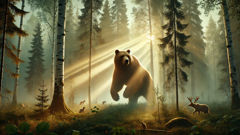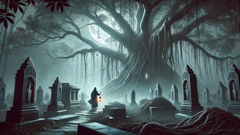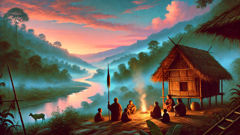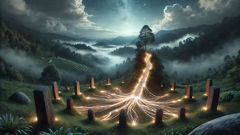Introduction
In the northern reaches of the ancient world, where the midnight sun lingers in summer and the polar night wraps the land in endless twilight, there lies a tapestry of emerald forests, glassy lakes, and whispering winds. This is Finland—Suomi—where every tree has a spirit, every stream a song, and every mountain a memory. Here, in this primeval realm, the wild is not merely background; it is alive, breathing, and sacred. The people of these lands, bound to the rhythms of nature, hold the bear in reverence above all other creatures. To them, the bear is not just a beast of the woods, but Otso—the King of the Forest, the one whose spirit bridges worlds seen and unseen. As legends swirl among the birches and pines, Otso’s presence is felt in every shadow that flickers beneath the canopy and in every hush that falls when paw prints mark the soft moss. To speak the bear’s true name is forbidden, for to do so would summon its gaze; instead, the people offer poetic titles and humble praises, honoring Otso as honey-paw, broad-browed one, or golden lord. The story that follows is older than the stones, woven by the firelight in snow-draped huts and sung beneath the aurora’s silent dance. It is a tale of awe and kinship, of the delicate balance between man and the wild, and of how Otso came to hold his throne among the roots and stars. Step into the hush of the ancient forest and listen—if your heart is open, you may still hear the King of the Forest breathing in the wind.
The Birth of Otso: A Gift from the Sky-Father
Long ago, before human feet trod paths through the dense, endless forests, the world was young and humming with creation. The gods looked down upon Finland’s emerald wilds and saw a land teeming with possibility but lacking a guardian to hold the balance between all living things. Ukko, the great Sky-Father, watched as forests grew thick and creatures flourished, but he sensed a fragile harmony—a balance easily tipped by hunger, fear, or pride.
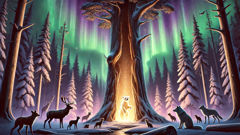
On a night when the moon hung heavy and low, Ukko plucked a tuft of golden cloud from the northern lights. He spun it with the silver threads of falling stars and whispered an ancient word that echoed across the hills and lakes. Where that word fell, a seed grew in the heart of the oldest pine atop a hill shrouded in mist. The tree’s roots quivered, the earth trembled, and from the hollow emerged a cub—not just any cub, but a being formed of starlight and dawn. His fur glowed amber and honey, his eyes gleamed with the wisdom of ages, and his breath sent ripples through the stillness. Thus was Otso born, the King of the Forest.
Otso grew swiftly under the care of Mielikki, goddess of the woods. She taught him the secrets of every tree and the names of every flower. He learned to walk softly among the deer, to run with the wolves, and to swim alongside otters. The creatures of the forest recognized something both familiar and strange in Otso—a kinship born not of blood, but of spirit. Birds perched on his back, squirrels nestled against his flank, and even the fierce lynx bowed its head as he passed.
The seasons turned, and with each passing year, Otso’s presence shaped the land. Where he trod, berries blossomed; where he slept, springs bubbled up clear and cold. But Otso was not only a giver—he was a keeper of balance. When wolves hunted too many hares, he would appear in their path, silent and vast, reminding them of restraint. When storms threatened to uproot trees, Otso’s roar would shake the sky and still the winds. His wisdom was sought by all; even the restless spirits of the north wind would hush to hear his counsel.
Yet, Otso’s greatest challenge came not from the wild, but from the first humans who arrived, drawn by the lure of fish-filled rivers and sheltering woods. These newcomers were small and frail compared to the ancient beasts, but they carried fire and cleverness. Otso watched as they built their homes and felled trees, always mindful of the delicate peace he was sworn to uphold. At first, people feared the mighty bear and kept their distance, whispering prayers and offering gifts at the forest’s edge.
One winter, famine struck. The rivers froze early, and game grew scarce. The people grew desperate and hungry. One night, as the northern lights shimmered above, a young woman named Aino crept into the woods with nothing but hope and a woven basket. She knelt by an ancient pine and sang a song of longing—not for herself, but for her kin who suffered. Her voice was soft as falling snow, yet it reached deep into the forest, stirring Otso from his den. The King of the Forest approached silently, and Aino did not flee. Instead, she lowered her gaze and offered the basket of dried berries she had saved from autumn.
Otso saw the humility and courage in Aino’s heart. He did not speak, but gently placed his paw upon the earth. Where it touched, the snow melted, revealing a cluster of mushrooms and roots—food for her people. Aino wept with gratitude and promised never to forget the gift or the lesson: to ask with humility and take only what was needed. She returned to her village, and from that day on, the people honored Otso as a spirit of mercy and wisdom, not just a beast of the woods.
So the legend grew—Otso, the King of the Forest, was not merely a guardian of animals, but a bridge between human and wild, a living reminder that every gift from the earth must be met with gratitude and respect.
The Sacred Pact: When Humans and Otso Meet
As generations passed, the people of Finland learned to live alongside Otso’s spirit, shaping their lives around the rhythms of the wild. Otso became more than a distant legend—he was woven into the fabric of every day, present in every ritual and every song. The people understood that the King of the Forest was both powerful and merciful, deserving of reverence and careful respect.
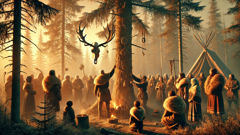
In every village, before the hunt began, elders led the people in solemn ceremony. They would gather at dawn near an ancient stone or beneath a sprawling oak, carrying offerings of honey, bread, and mead. The eldest among them would speak in hushed tones—not the bear’s true name, but his many titles: Golden Lord, Honey-Paw, Broad-Browed One. Children learned early to address Otso only in poetry, lest they draw his attention with careless words. They believed that to speak directly was to invite his spirit too close, risking misfortune or wrath.
When a hunt was necessary, the people acted with deep humility. If a bear’s life had to be taken to feed the village or clothe the children through another harsh winter, the ritual was slow and deliberate. Hunters prepared for days, fasting and praying beneath the stars. When the moment came, they approached the bear’s den singing songs of apology and honor. If Otso’s life was claimed, his spirit was treated as a guest. The skull was placed high upon a pine—never buried in earth—so his soul could return to the sky-father. Every bone was handled with care, every story told around the fire paid tribute to his memory. The feast that followed was not celebration but remembrance—a binding of people to nature, and nature to spirit.
Over time, tales spread of those who forgot the old ways. One such story was of Jari, a proud hunter from the southern lakes. Skilled with bow and spear, Jari grew arrogant in his success. He mocked the old rituals, claiming he needed no spirit’s blessing to master the forest. One autumn, he tracked a great bear through tangled undergrowth, heedless of the warnings whispered by his companions. When he felled the bear with a single arrow, he scoffed at tradition and left the skull unhonored.
That winter, misfortune followed Jari at every turn. His traps lay empty, his arrows snapped, and hunger gnawed at his family’s door. At night, he dreamed of golden eyes watching from the shadows and heard mournful songs in the wind. Desperate, Jari sought the counsel of the village elders. They listened and nodded gravely, reminding him that the pact with Otso was not superstition, but the heartbeat of the land itself. To live in balance was to thrive; to forget was to invite sorrow.
Humbled, Jari returned to the forest. Beneath a heavy sky, he found the pine where he’d left Otso’s remains. There, he sang the ancient songs and lifted the skull to the highest branch. As he did, the clouds parted and a shaft of sunlight fell upon him, warm even in winter’s chill. The next morning, game was plentiful again, and Jari never again forgot the pact.
In every corner of Finland, Otso’s legend grew stronger. Children left honey at the forest’s edge on midsummer’s night; mothers whispered prayers during storms. Even those who never saw a bear felt Otso’s gaze in the hush before dawn or the trembling of leaves on windless days. The sacred pact between people and Otso was more than ritual—it was a way of seeing the world: with humility, gratitude, and awe.
The Trials of Aino: Wisdom Gained in the Heart of the Wild
Years after her fateful meeting with Otso, Aino grew to be a respected wise woman in her village. She guided others not just with herbs and healing, but with stories—always reminding them of the forest’s generosity and mystery. Yet, even those who carry wisdom must be tested, for no bond with the wild remains unchallenged forever.
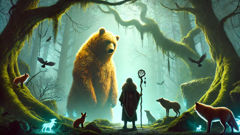
One spring, after an unusually harsh winter, signs of imbalance crept through the land. The salmon run failed, foxes prowled boldly at midday, and a strange restlessness troubled both people and beasts. Elders murmured of a shadow—a sickness in the heart of the forest. When children grew ill and berry patches withered overnight, Aino knew she must seek answers where others dared not tread.
Guided by dreams, Aino set out beneath a moonless sky. She carried only a staff carved with bear runes and a pouch of honeycomb. Deeper into the forest she went, where even the bravest hunters would not follow. The trees grew ancient and twisted; silence pressed in thick as moss. At last, she reached a glade bathed in faint green light. There, Otso waited—larger than she remembered, his fur shimmering with starlight, his eyes reflecting both kindness and sorrow.
Otso spoke not in words, but in images and feelings. Aino saw visions of careless fires that scarred the land, of hunters who took more than they needed, of rivers choked with greed. The sickness was not only in the soil, but in hearts grown forgetful of old promises. To heal the forest, Aino would have to remind her people—and herself—of humility, patience, and trust.
Otso led her on a journey through secret places: hidden springs bubbling beneath stone, groves where foxes danced under moonlight, cliffs where eagles rode the wind. With each step, Aino learned again what it meant to listen, to wait, and to give thanks for every gift. She gathered rare herbs and whispered apologies to trees whose roots had been wounded. When her journey ended, Otso pressed his great forehead to hers, filling her with peace and a wisdom as deep as winter.
Returning to her village, Aino shared what she had learned. She taught children to greet every dawn with gratitude, to share harvests with those in need, and to remember that even the smallest kindness ripples through the world. The sickness faded, salmon returned to the rivers, and berries blushed thick on every bush. The bond between Otso and his people was renewed, stronger than before—woven not just through ritual, but through everyday acts of care and wonder.
Aino’s story became part of every winter’s tale: a reminder that wisdom is not a gift granted once and kept forever, but a flame that must be kindled anew with each generation. In honoring Otso, the people learned to honor themselves and all living things.
Conclusion
To this day, in the deep woods of Finland where sunlight filters through silver birch and shadowed pine, Otso’s spirit lingers. He is more than myth; he is a presence felt in every hush before dawn, in the glint of dew on moss, and in the gentle rustle of branches swaying high above. The story of Otso—the King of the Forest—reminds all who listen that nature’s gifts are not endless nor owed. Balance must be kept, respect freely given. The ancient pacts endure in the humble rituals of honey left on stumps, in songs whispered to the wind, and in every careful footstep along forest trails. When storms threaten or hunger prowls at village doors, the wise still recall Aino’s courage and Otso’s mercy: that to ask with gratitude is to be answered with abundance, and to forget humility is to invite the wild’s stern lesson. In honoring Otso, people do not worship the bear alone; they honor every living thread woven through the tapestry of their homeland—knowing that to cherish the wild is to cherish themselves. As long as stories are told by firelight and stars shimmer above silent lakes, the legend of Otso endures—guardian, king, and bridge between worlds.

